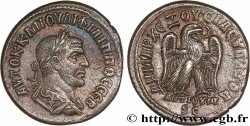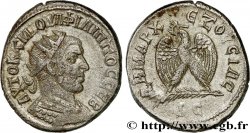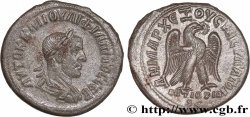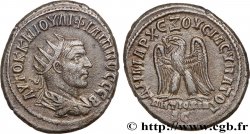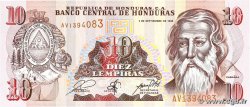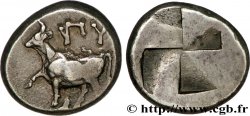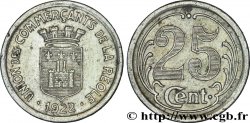Not available.
Item sold on our e-shop (2011)
Price : 280.00 €
Item sold on our e-shop (2011)
Price : 280.00 €
Type : Tétradrachme syro-phénicien
Date: 244
Mint name / Town : Antioche, Syrie, Séleucie et Piérie
Metal : billon
Diameter : 28,00 mm
Orientation dies : 6 h.
Weight : 13,77 g.
Rarity : R1
Coments on the condition:
Exemplaire sur un flan ovale parfaitement centré des deux côtés avec les grènetis visibles. Très beau portrait de Philippe Ier de haut relief bien venu à la frappe. Très joli revers sans usure. Magnifique patine gris métallique avec des reflets mordorés irisés. Conserve la plus grande partie de son brillant de frappe et de son coupant d’origine
Catalogue references :
Prieur 308 (18 ex)
Predigree :
Dans la base TSP maintenue par Michel Prieur, vingt-sept exemplaires sont maintenant répertoriés pour la quatrième officine. Notre exemplaire, qui provient de la trouvaille dite Syrie 1930, est le 0308_019
Obverse
Obverse description : Buste lauré, drapé et cuirassé de Philippe Ier à droite, vu de trois quarts en arrière (A*2).
Obverse legend : AUTOK K M IOUL FILIPPOU SEB, (Autokratoros Kaisaros Markos Ioulios Filippos Sebastos)
Obverse translation : (L’empereur césar Marc Jules Philippe auguste).
Reverse
Reverse legend : S|C// MON VRB À L’EXERGUE // DELTA DANS LE CHAMP.
Reverse description : Aigle debout à droite, les ailes déployées, tête et queue à gauche, tenant une couronne feuillée dans son bec, sans ligne de terre.
Reverse legend : DHMARC - EX OUSIAS, (Dhmarcikhs Ex Ousias)
Reverse translation : (Revêtu de la puissance tribunitienne/ Monnaie de la Ville / avec l’accord du Sénat).
Commentary
Rubans de type 2 aux extrémités bouletées. Ptéryges fines sous le paludamentum. Les premières émissions de Philippe se subdivisent en frappes sans marque d’officine et avec ligne de terre, frappes sans marque d’officine et sans ligne de terre, puis frappes avec marques d’officine et sans ligne de terre.
Notre exemplaire appartient à cette catégorie, pour la quatrième officine (Delta), qui, sans être aussi rare que la deuxième officine, se rencontre assez difficilement.
La question du lieu de frappe, au sens de fabrication et non de mise en circulation, a été tranchée par H. R. Baldus, Moneta Urbis - Antioxia, Francfort 1969, et il semble bien que ces monnaies ont été fabriquées à Rome, plutôt qu’à Antioche.
Le raisonnement de H.R. Baldus concernant cette émission de Philippe repose avant tout sur la signature de l’atelier au revers : dans le monde romain, l’Urbs, la Ville, ne peut être que Rome. Le cas n’est pas isolé et il a été déterminé, par exemple, que des tétradrachmes d’Alexandrie pour Sévère Alexandre avaient été frappés à Rome puis envoyés en Égypte ; on peut penser que des questions de prix de revient et de qualité de fabrication furent à l’origine de ces migrations.
Effectivement, les portraits de cette émission sont exceptionnellement bons, équivalents aux meilleurs sesterces de l’atelier de Rome.
Autre particularité de cette émission, le retour du SC, disparu des revers entre 242 et 244, après avoir remplacé à Antioche le Delta Eta apparu en 215, et jamais vu dans un autre atelier officiel. Si nous suivons la logique développée pour ces émissions, il faut croire que ces frappes de Philippe ont reçu l’assentiment (au moins) et le financement (au plus) du sénat d’Antioche. Une gigantesque rançon ayant été payée aux Perses pour abréger la guerre, le propre frère de Philippe étant gouverneur de Syrie, sa propre famille en étant originaire, on peut au moins penser que le Sénat regagna de son importance de l’époque des Sévères. La réputation de Priscus étant de pressurer la population - au point de susciter l’usurpateur Jotapian - on peut aussi penser que le produit de ces spoliations servit à frapper des tétradrachmes au portrait et donc à la gloire de l’Empereur.
On note que les sigma sont gravés en C.
.
Type 2 ribbons with pelleted ends. Thin pteryges under the paludamentum. The first issues of Philippe are subdivided into strikes without an office mark and with a ground line, strikes without an office mark and without a ground line, then strikes with an office mark and without a ground line..
Our specimen belongs to this category, for the fourth pharmacy (Delta), which, without being as rare as the second pharmacy, is quite difficult to find..
The question of the place of minting, in the sense of manufacture and not of putting into circulation, was decided by H. R. Baldus, Moneta Urbis - Antioxia, Frankfurt 1969, and it seems that these coins were made in Rome, rather than in Antioch.
H's reasoning. R. Baldus's opinion on this issue of Philip rests above all on the workshop signature on the reverse: in the Roman world, the Urbs, the City, can only be Rome.. This is not an isolated case and it has been determined, for example, that Alexandrian tetradrachms for Severus Alexander were minted in Rome and then sent to Egypt; it is possible to assume that questions of cost price and manufacturing quality were at the origin of these migrations..
Indeed, the portraits in this issue are exceptionally good, equivalent to the best sesterces from the Roman workshop..
Another particularity of this issue is the return of the SC, which disappeared from the reverses between 242 and 244, after having replaced the Delta Eta in Antioch, which appeared in 215, and never seen in another official mint.. If we follow the logic developed for these emissions, we must believe that these strikes of Philip received the assent (at least) and the financing (at most) of the senate of Antioch. A gigantic ransom having been paid to the Persians to shorten the war, Philip's own brother being governor of Syria, his own family being from there, one can at least think that the Senate regained its importance of the time of the Severans. Priscus's reputation for squeezing the population - to the point of giving rise to the usurper Jotapian - we can also think that the product of these spoliations was used to strike tetradrachms with the portrait and therefore to the glory of the Emperor..
Note that the sigmas are engraved in C.
Notre exemplaire appartient à cette catégorie, pour la quatrième officine (Delta), qui, sans être aussi rare que la deuxième officine, se rencontre assez difficilement.
La question du lieu de frappe, au sens de fabrication et non de mise en circulation, a été tranchée par H. R. Baldus, Moneta Urbis - Antioxia, Francfort 1969, et il semble bien que ces monnaies ont été fabriquées à Rome, plutôt qu’à Antioche.
Le raisonnement de H.R. Baldus concernant cette émission de Philippe repose avant tout sur la signature de l’atelier au revers : dans le monde romain, l’Urbs, la Ville, ne peut être que Rome. Le cas n’est pas isolé et il a été déterminé, par exemple, que des tétradrachmes d’Alexandrie pour Sévère Alexandre avaient été frappés à Rome puis envoyés en Égypte ; on peut penser que des questions de prix de revient et de qualité de fabrication furent à l’origine de ces migrations.
Effectivement, les portraits de cette émission sont exceptionnellement bons, équivalents aux meilleurs sesterces de l’atelier de Rome.
Autre particularité de cette émission, le retour du SC, disparu des revers entre 242 et 244, après avoir remplacé à Antioche le Delta Eta apparu en 215, et jamais vu dans un autre atelier officiel. Si nous suivons la logique développée pour ces émissions, il faut croire que ces frappes de Philippe ont reçu l’assentiment (au moins) et le financement (au plus) du sénat d’Antioche. Une gigantesque rançon ayant été payée aux Perses pour abréger la guerre, le propre frère de Philippe étant gouverneur de Syrie, sa propre famille en étant originaire, on peut au moins penser que le Sénat regagna de son importance de l’époque des Sévères. La réputation de Priscus étant de pressurer la population - au point de susciter l’usurpateur Jotapian - on peut aussi penser que le produit de ces spoliations servit à frapper des tétradrachmes au portrait et donc à la gloire de l’Empereur.
On note que les sigma sont gravés en C.
.
Type 2 ribbons with pelleted ends. Thin pteryges under the paludamentum. The first issues of Philippe are subdivided into strikes without an office mark and with a ground line, strikes without an office mark and without a ground line, then strikes with an office mark and without a ground line..
Our specimen belongs to this category, for the fourth pharmacy (Delta), which, without being as rare as the second pharmacy, is quite difficult to find..
The question of the place of minting, in the sense of manufacture and not of putting into circulation, was decided by H. R. Baldus, Moneta Urbis - Antioxia, Frankfurt 1969, and it seems that these coins were made in Rome, rather than in Antioch.
H's reasoning. R. Baldus's opinion on this issue of Philip rests above all on the workshop signature on the reverse: in the Roman world, the Urbs, the City, can only be Rome.. This is not an isolated case and it has been determined, for example, that Alexandrian tetradrachms for Severus Alexander were minted in Rome and then sent to Egypt; it is possible to assume that questions of cost price and manufacturing quality were at the origin of these migrations..
Indeed, the portraits in this issue are exceptionally good, equivalent to the best sesterces from the Roman workshop..
Another particularity of this issue is the return of the SC, which disappeared from the reverses between 242 and 244, after having replaced the Delta Eta in Antioch, which appeared in 215, and never seen in another official mint.. If we follow the logic developed for these emissions, we must believe that these strikes of Philip received the assent (at least) and the financing (at most) of the senate of Antioch. A gigantic ransom having been paid to the Persians to shorten the war, Philip's own brother being governor of Syria, his own family being from there, one can at least think that the Senate regained its importance of the time of the Severans. Priscus's reputation for squeezing the population - to the point of giving rise to the usurper Jotapian - we can also think that the product of these spoliations was used to strike tetradrachms with the portrait and therefore to the glory of the Emperor..
Note that the sigmas are engraved in C.








 Report a mistake
Report a mistake Print the page
Print the page Share my selection
Share my selection Ask a question
Ask a question Consign / sell
Consign / sell
 Full data
Full data